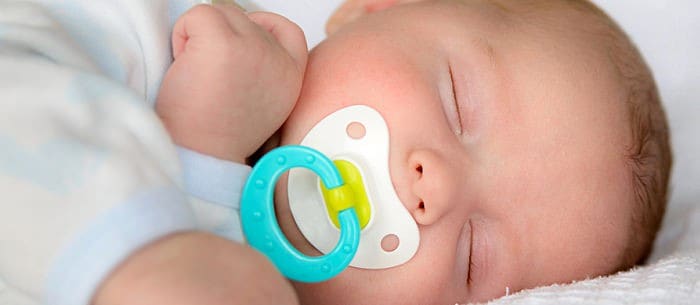It’s midnight, and you’re standing in your baby’s bedroom, pacifier in hand, wondering if it’ll get him to stop crying. You’re nervous. You’ve heard time and again that giving your baby a pacifier can cause nipple confusion and interfere with nursing. Could using a pacifier even lead to childhood orthodontics? And you definitely don’t want to be the mom of a 5-year old who is still attached to his binky! Two experts weigh in on the pros and cons of pacifier use so you can make an informed decision.
- What Are the Benefits of Using a Pacifier?
Pacifiers are the go-to gadget for many parents when soothing their crying baby. In fact, Dr. Jill Lasky, a Harvard-trained pediatric dentist, agrees that “non-nutritive sucking helps soothe infants and toddlers and can calm or reboot the nervous system.” What else can a pacifier do for your baby? Dr. Natasha Burgert, a pediatrician and blogger at KC Kids Doc, says that in some cases, babies with a strong sucking reflex can benefit from pacifiers. “Infants with a strong sucking reflex — who don’t use a pacifier — have a tendency to be overfed, which may not be healthy,” she says. A pacifier allows the baby to be satisfied without eating, and in some cases, doctors might introduce one if the baby is gaining too much weight.
- What Are the Drawbacks of Using a Pacifier?
Will pacifier use hinder your baby’s dental formation? According to Lasky, there is some truth to that. She states, “Prolonged pacifier use has a high likelihood of affecting the jaw and bone structure of the child, resulting in open or crossbites.” How babies suck their pacifier may be a greater contributing factor to teeth development. According to Lasky, those who more aggressively suck their pacifiers — as opposed more passively sucking or holding it in their mouth — may be more prone to an open or crossbite in the future. However, Lasky reassures parents that “a large percentage of the distortion self-corrects when the pacifier habit is over. ” In addition, regardless of pacifier use, many children end up needing orthodontic correction — so you can’t say that those children wouldn’t have needed braces had they not used a pacifier.Both doctors agree that pacifiers can contribute to delayed speech, speech impediments and articulation problems — particularly when used during play and socialization time — as they try to talk around the pacifier or make fewer attempts to talk altogether. Other drawbacks include the increased spread of germs, parental frustration when searching for misplaced Binkies — especially if it’s the only way to soothe your little one — and difficulty weaning when it’s time to pull the plug.
To gently begin the transition away from the pacifier, both doctors recommend setting guidelines to limit use such as only during nap time, bedtime or in the car and gradually limiting from there. Burgert recommends beginning such restrictions between ages 15-18 months when the child is more flexible. “After age 2, they are more developmentally black and white and have difficulty understanding why they can have it sometimes and not others, in which case, going cold turkey and taking it away entirely may be easier for them to comprehend,” she says.
- Will It Interfere With Nursing?
Perhaps the most widely debated question is whether pacifier use causes nipple confusion and hurts the nursing relationship. Burgert states, “Anecdotally and observationally, I do not see nipple confusion. The jury is out. Though some people are very anti-pacifier, there is some support that it can actually improve nursing. With appropriate use and guidance from a lactation consultant, pediatrician or occupational therapist, pacifiers can be used to increase jaw strength and coordination to increase nursing and improve breastfeeding.” Burgert does recommend limited use of pacifiers until nursing is well-established and birth weight is regained. The ideal window for introduction is between two and four weeks. If you wait too long, the baby will likely refuse the pacifier. To support nursing, always offer the breast first and then the pacifier if the breast is rejected, and never use the pacifier to delay a feeding — this is a no-no whether bottle or breastfeeding, according to the American Academy of Pediatrics.
- What Type of Pacifier Should You Use?
If you make the decision to use a pacifier, there are two types of pacifiers to consider: those that are rounded and more closely resemble the nipple, and orthodontic ones that are flatter in shape. Burgert recommends starting with the more natural nipple if you’re breastfeeding and notes that, if you’re bottle-feeding, most bottle brands offer a pacifier that matches their feeding system, so it’s best to elect for that one. She recommends that you change the pacifier size as your child ages, as kids may choke on pacifiers that are too small for them. She also suggests the use of an orthodontic one once your baby gets her first teeth, as round ones may be more likely to crack under the stress of teeth. Whatever type you choose, it’s important to be diligent and to immediately discard and replace pacifiers showing signs of wear.
Victoria Georgoff is a freelance writer and therapist who enjoys writing about parenting, helping other parents, and of course, being a parent herself.
* This article is for general informational purposes only. It is not intended nor implied to be providing medical advice and is not a substitute for such advice. The reader should always consult a health care provider concerning any medical condition or treatment plan. Neither Care.com nor the author assumes any responsibility or liability with respect to use of any information contained herein.






